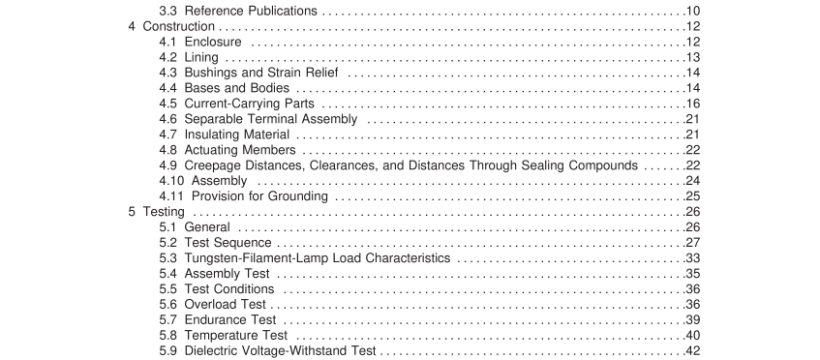UL 20-2010 pdf download.General-Use Snap Switches.
1 .1 The requirements of this Standard apply to manually operated, general-use snap switches for connection to copper (Cu) or copper-clad conductors used in accordance with the National Electrical Code(NEC), ANSI/NFPA 70, or the Canadian Electrical Code (CEC), Part I, and intended for connection to wiring systems recognized by the NEC or the CEC, Part I. In Canada, requirements for switches for connection to aluminum (Al) conductors used in accordance with the CEC, Part I, and intended for connection to wiring systems recognized by the CEC, Part I, are covered in Annex B. 1 .2 This Standard applies to ac/dc rated switches for which the load ratings do not exceed 60 A at 250 V or less, 30 A at 251 V – 600 V, and 2 hp at 1 25 V – 600 V or less. This Standard also covers ac-only rated switches for which the load ratings do not exceed 30 A at 347 Vac or less. 1 .3 This Standard applies to switches constructed to be installed readily in a flush device box or on an outlet-box cover and intended for connection to branch-circuit wiring. 1 .4 This Standard applies to pendant and through-cord switches intended for field installation on flexible cord and provided with one “on” and one “off” position. 1 .5 This Standard applies to switches intended for surface mounting and provided with a separable base and cover for connection to exposed wiring consisting of nonmetallic sheathed cable or open wiring on insulators (knob and tube). 1 .6 This Standard applies to self-contained switches intended for flush mounting without a separate outlet box and for connection to branch-circuit wiring consisting of one or more non-metallic sheathed cables containing copper conductors. 1 .7 This Standard applies to ac/dc fixture switches intended to be installed in fixtures to control incandescent lighting or fans for connection to branch-circuit wiring.
2.1 The following definitions apply in this Standard: 2.2 CLEARANCES – through-air spacing. 2.3 CREEPAGE DISTANCES (CREEPAGE) – over-surface spacings. 2.4 DOOR SWITCH – a single-pole, momentary contact switch with a push-button actuator, provided with an outlet-box and cover. It is intended for installation in door jambs to control lighting fixtures, typically in a closet. 2.5 FIXTURE SWITCH – a switch installed in the enclosure of a fixture such as a luminaire, a fan or the like. 2.6 FLUSH SWITCH – a switch provided with a mounting yoke or integral flush device cover plate and intended for installation in or on an outlet box intended to control a branch circuit. 2.7 PENDANT SWITCH – a switch intended to be installed at the end of a flexible cord for use in branch-circuit pendant applications. 2.8 SELF-CONTAINED SWITCH – a switch intended for flush mounting without a separate outlet box for connection to one or more nonmetallic sheathed cables containing copper conductors. 2.9 SURFACE SWITCH – a switch provided with a separable base and cover primarily intended for branch-circuit installation on exposed wiring consisting of open wiring on insulators or nonmetallic sheathed cable. 2.1 0 TERMINAL ASSEMBLY, SEPARABLE – A two-piece terminal assembly provided with an integral mechanical latching mechanism(s). It consists of permanently attached pins or tabs located on the body of the switch which are capable of receiving a special purpose connector with leads for connection to the branch circuit.
3 General 3.1 Components 3.1 .1 Except as indicated in 3.1 .2, a component of a product covered by this Standard shall comply with the requirements for that component. See Annex A for a list of Standards covering components generally used in the products covered by this Standard. A component shall comply with the Canadian Standards Association or the Underwriters Laboratories Inc., standards as appropriate for the country where the product is to be used. 3.1 .2 A component need not comply with a specific requirement that: a) involves a feature or characteristic not needed in the application of the component in the product covered by this Standard; or b) is superseded by a requirement in this Standard. 3.1 .3 A component shall be used in accordance with its ratings for the intended conditions of use. 3.1 .4 Specific components are accepted as being incomplete in construction features, or restricted in performance capabilities. Such components are intended for use only under limited conditions, such as temperatures not exceeding specified limits, and shall be used only under those specified conditions for which they have been investigated. 3.2 Units of Measurement 3.2.1 If a value for measurement is followed by a value in other units in parenthesis, the second value may be only approximate. The first stated value is the requirement.UL 20-2010 pdf download.
UL 20-2010 pdf download
